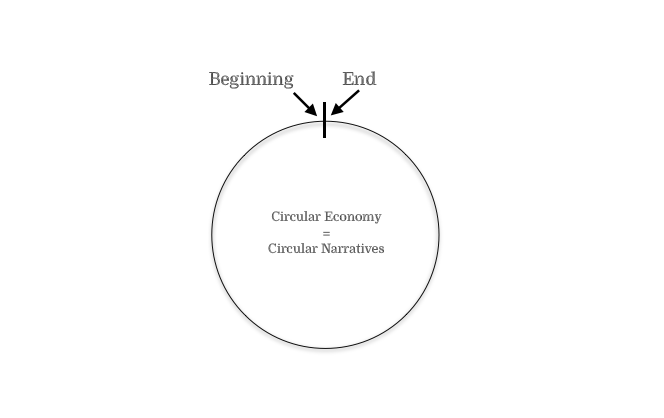If sustainability ought to stand a chance we must detach ourselves from an objective and dry language that describes something, we should be very emotionally involved with – global warming. Environmentalists, politicians, and corporations must mediate fact and information in a way that is appealing and easy to internalize for people, since we will deny facts if the rhetorical framework is not relatable to us.
(Scroll down half-way for commonly used metaphors and to the bottom for old and new words).
The way we speak and write mirrors our culture, our priorities, and our values. What we find important we liken with what our society considers most valuable, which is often gold, oil or mechanics. Through my years working with sustainability and culture, I’ve often asked a client why they compare something good with something e.g. mining, from which they just minutes ago took a stance. They had not even thought about it.
While studying the narratives of circular economy the past months, I extended my research also to count the metaphors of sustainability and unsustainability. This article will explore our way of manifesting unsustainability and the potential for creating a sustainable reality by “talking the walk” – changing our language and metaphors.
First it is necessary to look at the cultural value-chain. See what I did here? I transformed Keith Oliver’s term “Supply-Chain” from 1982 into “value-chain”. I did so not only to make my argument more attractive to a business audience but also to use a phrase that automatically resonates a pre-taught image and understanding underlining that the values are interconnected. Is “value-chain” the right word to use? Does the word “chain” represent the reality I want? Perhaps, perhaps not – at least a chain is an image of something connected.
My hope is that this linguistic and narrative exploration will give insight to employees in Corporate Social Responsibility departments, activists, environmentalists, policy and change makers, and those who are innovating a greener future.
VALUES AND IDENTIFICATION
In a world where we are facing climate change so rapid that many smaller islands are drowning in rising seas, and the citizens of China’s biggest cities must stay inside most days due to smog clogging their lungs, there is a lot to be concerned about.
When China and the United States, the biggest polluters on our planet, finally agreed on in collaboration, to limit their carbon footprint they sent a message to humans of the planet, that the governments finally are willing to do what they are supposed to – care about their people. Why did it take so many decades to act? To most citizens, it seemed incomprehensible, but for governments who are sustained by certain people and companies supporting the administration with trillions of dollars every year, it was harder to set a “chair in front of the door”. It took much courage to state publicly what the US and China’s supporters in the oil and mining industries are doing is ruining the health of both planet and people.
The governments established a value, and, therefore, a point of identification. The value was our planet and the survival of humanity. How did we linguistically go about it in the US? The deal was described, using sport and apocalyptic metaphors, on Gist.org and other online media hubs as “avert catastrophic climate change”; ““best efforts” to hit the higher end of that range” (grist.org[1]).
Catastrophes and sport are metaphorical representatives of what we ascribe to values, both negative and positive ones. Metaphors allow us to conceptualize what we have a hard time explaining, or allow us to link the subject to something else and thereby create an emotional attachment. Though the climate and natural world have very little to do with sports, we all recognize the emotion of “hitting the higher range” as in “winning”, and we all know the relieving feeling of “averting a catastrophe” – phew!
These two metaphor classes represent the exact opposite of one another, extremes: winning or losing, dying or living, succeeding or failing. The words get the message through but sound rather bi-polar. The philosophical approach then would be to question, if this form of polarized language and storytelling is contributing to a healthy narrative about our world. Metaphors are very important rhetoric tools as they allow us to comprehend one thing in terms of another, but also allow us to make something very abstract, like climate change, concrete and relatable to everyday life.
Everyday life and metaphors are commonly not considered scientific objectivity. If we take a look at companies’ CSR and communication strategies, we see that the texts are often robbed of powerful storytelling potential because the intention is to appear serious and scientific. Unfortunately, it leaves the discussions on climate change rather insignificant and dry and is not very engaging.
There is huge potential for improving communication and CSR strategies. Especially if we manage to engage our stakeholders and readers by using language and metaphors that mirror the sustainable cultures for which we strive. As I mentioned in this report’s part 1, adopting a circular narrative structure would help readers with internalizing the circular. It would put a circular form to a circular plot. Inspiration could easily be found in works of writers like Mark Twain and Harriet Beecher Stove, who created political change by engaging their readers emotionally with stories about anti-slavery. The emotional change within their readers contributed to the successful abolition of enslavement in the United States.
Fortunately, professional communicators and companies are becoming aware that language also represents an ideology, but we still have a long way to go, and it is interesting when people who are striving for an organic and natural reality use e.g. mechanical body and life metaphors. Other words found in texts about biology and sustainability that do not represent the regenerative or natural are mechanisms, operations, hierarchy, fragmentation, assembly rules, catastrophe, kingdom, invasive, etc.
My most interesting find while reading shareholder reports was that we speak about “crisis” and “life-systems” if events occur that challenge our human control over Nature.
However, if our dream is to co-exist with the natural world, we cannot use language that indicates humanity’s control over it. We must get to get to grips with this ideological disconnect.
Commonly used metaphors:
- Time is money – This is an example of a linear narrative in which time is directly related to the value money. This metaphor also treats time as something consistent, even though our perception of it might accelerate or slow down depending on in what we engage.
- Investing in a relationship – A metaphor with roots in the financial world that is defining input and outcome.
- To tackle a problem – A sport’s metaphor.
- Her idea is a goldmine for the company – Again, a metaphor likened with currency financial wealth. However, in a time where the focus is on biodiversity and a green planet should it not be called a rainforest instead of a goldmine?
- As citizens and professional communicators, it is our responsibility to be consciously aware of our language use and how we interpret what we read. We should try not to replicate an ideology we want to distance ourselves from. In the last decades heated debates about climate change, it has been obvious that political and religious views overrule facts and science. What makes people act for or against a sustainable future is often due to emotional ties to one’s values.
If sustainability ought to stand a chance we must detach ourselves from an objective and dry language that describes something, we should be very emotionally involved with – global warming. Environmentalists, politicians, and corporations must mediate fact and information in a way that is appealing and easy to internalize for people since we will deny facts if the rhetorical framework is not relatable to us.
If we cast a look at political parties, NGO’s, and corporations they usually have a guide that describes the accepted and unaccepted lingo in the organization. This is not a very liberal approach, but it helps these bodies form a relatable language, almost a mantra, to which people become familiar. From a persuasive point of view, this cultivation of language and ideas is exceptionally effective. It should be considered to develop such agendas that environmentalists and pro-Nature organizations could ascribe to.
CREATING NEW WORDS AND METAPHORS
Creating new metaphors and words for sustainability is a social action. To be enlightened of one’s cultural context helps one understand how we sustain certain narratives or ideologies through words and fixed meanings like metaphors. If the intention is to change cultures and achieve a paradigm shift, then using a language guide or tool is a way of developing awareness of our unsustainable heritage and gaining concrete examples of how to narrate differently.
Ideas for language transformation:
- Circular Narratives: If you strive towards a circular economy and culture then use a circular narrative when mediating. Circular narratives begin and end in the same scene, but the narrator often return to their starting point as more clever selves. This is also a very good technique for persuasion.
- Get rid of your mechanical metaphors: Mechanical metaphors like “body mechanics”, “the planet is a fantastic system”, and others represent an industrial worldview and not a natural one. If we want an organic and natural world, it makes no sense referring to it as a machine. A word to look at: Think-Tank. What if we used the word “Thinkery” instead? It would reflect the action and not the “container” as the word “tank” does. It would also resemble the word “Nursery” A place where you grow plants. So, in a “Thinkery” you grow thoughts.
- Replace human-centered words with nature-centered words: We are all part of Nature, but if we use words that are only human-centered we don’t express that we share this world with other living creatures. A word to look at: Nation – Nation is old French and means a large number of people, or people from the same race, living in an area. The word “Biome” means a large area in which living creatures exists, counting ALL life-forms. Saying the Biome of China instead of the Nation of China would force us to think of their animals and plants to and in this way we would get a much more diverse view on what is a “Nation”.

